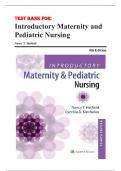Exam (elaborations)
Test Bank for Introductory Maternity and Pediatric Nursing 4th Edition Hatfield ISBN 9781496346643 Chapter 1-42| Complete Guide A+
- Course
- Institution
- Book
Test Bank for Introductory Maternity and Pediatric Nursing 4th Edition Hatfield Test Bank. Table of contents; Chapter 1: The Nurse's Role in a Changing Maternal–Child Health Care Environment Chapter 2: Family-Centered and Community-Based Maternal and Pediatric Nursing Chapter 3: Structure and Fun...
[Show more]



